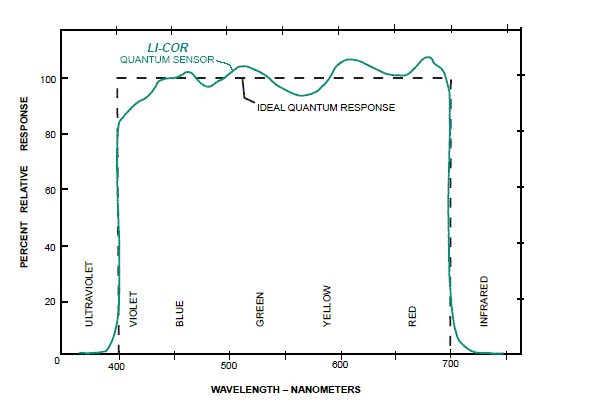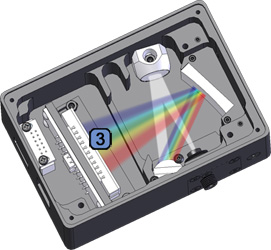You are using an out of date browser. It may not display this or other websites correctly.
You should upgrade or use an alternative browser.
You should upgrade or use an alternative browser.
DIY Arduino PAR Meter?
- Thread starter ageno125
- Start date
I've been working arduinos for a bit now... and wanted to build a par meter.
anyone know of a quality build sensor ? or experienced in building a par meter?
Google parduino. I believe the publication was in ag and forest met. It has the details you want on how to do this.
oreo57
Well-known member
According to this you hook a $400 Li-Cor to it..
https://academic.oup.com/treephys/article-lookup/doi/10.1093/treephys/tpu044
For $500 you get an equiv.. data logger/sensor..
http://www.apogeeinstruments.com/mq-500-full-spectrum-quantum-meter/
how to build a sensor:
https://www.for.gov.bc.ca/hfd/pubs/Docs/wp/wp53.pdf
Need to add the ADC and aduino bits..
https://academic.oup.com/treephys/article-lookup/doi/10.1093/treephys/tpu044
For $500 you get an equiv.. data logger/sensor..
http://www.apogeeinstruments.com/mq-500-full-spectrum-quantum-meter/
how to build a sensor:
https://www.for.gov.bc.ca/hfd/pubs/Docs/wp/wp53.pdf
Need to add the ADC and aduino bits..
2smokes
In Memoriam
If you really want to build something DIY then build a tool better than any PAR meter,a spectrometer that measures all the colors intensity not only the red and blue like the par meter.A par meter sensor is just a photodiode(or 2) sensor like any cheap LUX meter has but the par meter has it covered with a red piece of plastic and a blue one-the color filters.You dont even need an arduino to build the spectrometer .For the sensor build you would need a computer camera(its not important to be high resolution because it needs to see just the basic colors) and a lux meter sensor.Optionally you could add also an UV sensor from a cheap UV meter-theyre verry accurate.You would also need a difraction grating made from a compact disk.Encase the spectrometer in resin and make it waterproof then measure the spectrum and go on a math site to transform the pictures with the spectrum into graphics and then by using the whoole light intensity from the lux meter sensor you can calculate how intense is each color .You will get with an instrument much better than a par meterbecause this tell you exactly how much red light is ,how much blue or any otther color while the PAR meter doesnt makes the difference between red and blue.A par meter tells you the PAR value but you dont know what the red and bue ratios are and you could have high PAR for a light that has 100 percent red in it wich is useless in reef tank.More info here http://www.reefcentral.com/forums/showthread.php?t=2606060&highlight=spectrometer
If you really want to build something DIY then build a tool better than any PAR meter,a spectrometer that measures all the colors intensity not only the red and blue like the par meter.A par meter sensor is just a photodiode(or 2) sensor like any cheap LUX meter has but the par meter has it covered with a red piece of plastic and a blue one-the color filters.You dont even need an arduino to build the spectrometer .For the sensor build you would need a computer camera(its not important to be high resolution because it needs to see just the basic colors) and a lux meter sensor.Optionally you could add also an UV sensor from a cheap UV meter-theyre verry accurate.You would also need a difraction grating made from a compact disk.Encase the spectrometer in resin and make it waterproof then measure the spectrum and go on a math site to transform the pictures with the spectrum into graphics and then by using the whoole light intensity from the lux meter sensor you can calculate how intense is each color .You will get with an instrument much better than a par meterbecause this tell you exactly how much red light is ,how much blue or any otther color while the PAR meter doesnt makes the difference between red and blue.A par meter tells you the PAR value but you dont know what the red and bue ratios are and you could have high PAR for a light that has 100 percent red in it wich is useless in reef tank.More info here http://www.reefcentral.com/forums/showthread.php?t=2606060&highlight=spectrometer
I just want to point out that PAR and a PAR sensor have little to do with what is described above.
PAR (Photosynthetically Active Radiation) is not composed of solely blue and red light. PAR defines a band that encompasses light with a wave length between 400 and 700 nm, and counts all photons with a wavelength in that band the same. This means it includes most all the visible spectrum. And it is defined as such because all photons in that band have enough energy to get chlorophyll excited to the first singlet state. The red/blue thing comes from the absorption peaks of chlorophyll, and is only loosely related to how PAR is defined because chlorophyll does not exist in isolation in the antenna complex. I would suggest looking into some of the early work on action spectra and how this lead to PAR if you wish to understand this better.
As to PAR sensors, there are no red or blue chunks of plastic in them. Most commercial sensors follow one of two basic designs; either a diode detector calibrated in PAR to the spectral distribution of a specific light source, or a diode detector with a bandpass filter that provides a flat spectral response across the PAR waveband. In either case the sensor is more than just a photodiode.
As to a LUX sensor being similar to a PAR sensor, they are not. LUX is based on the spectral response of the human eye. So while PAR would count a green photon the same as a red or blue photon, a lux meter would count the green photon with considerably more weight than a red or blue one. Similarly though a LUX sensor would use a similar filtering system to achieve the desired spectral response.
2smokes
In Memoriam
A lux meter measures intensity of light.Its a photodiode and its same photodiode thats used in a par meter just the par meter measures only the red and blue not the whhole spectrum.The spectrometer i proposed to be built its much more accurate than any otther par meter on the market.This is the PAR meter sensor,just a diode with colored glass (only red and blue)filters on top of it.And a par meter does not tell you the exact ratio between red and blue while with the spectrometer you could see how much red and how much blue and otther colors intensity is. Read this to see i am right and learn how a PAR meter works. http://www.advancedaquarist.com/2013/2/equipment And this is the PAR meter sensor from that article .
 And this is how the result of the spectrometer proposed by me should look like after you turn the picture with the spectrum into a graphic .You would need a lux meter sensor to find the whoole spectrum intensity asside from the spetrum colors.Based on these informations you can calculate easy each color intensity.To find out PAR value you only need to to know blue and red intensity.
And this is how the result of the spectrometer proposed by me should look like after you turn the picture with the spectrum into a graphic .You would need a lux meter sensor to find the whoole spectrum intensity asside from the spetrum colors.Based on these informations you can calculate easy each color intensity.To find out PAR value you only need to to know blue and red intensity.



Last edited:
oreo57
Well-known member
You're conflicting PAr w/ PUR (photosythectically useable radiation)
PUR would need to be calculated based on the actual useage of ind. organisms.. A daunting task..
PAR "as defined" and measured is basically this (the red square):

Li-COr (best of class) quantum PAR meter response:

some of this is just terminology..
As to converting LUX sensors to more accurate "PAR" sensors one just needs to remove the green filter.. and understand the basic response of the underlying sensor.
As to making spectrophotometers.. well that is in another class by itself, though the underlying hardware is "relatively" simple..
directed light path.. diffraction grating or prism, and a linear CCD or CMOS

http://bwtek.com/spectrometer-part-3a-the-detector/
Actually is easier than it looks.. but getting accuracy and precision is the tricky part..
and the software.. always the software..
Main problem is most "sensors" are not very linear in an entire band..

thus the use of filters and "magic" to smooth the graph out to the flat topped response in the 400-700nm range (for visual light) and to "cut" the tails after 400 and 700nm..

http://www.rags-int-inc.com/phototechstuff/pipeline/
PUR would need to be calculated based on the actual useage of ind. organisms.. A daunting task..
PAR "as defined" and measured is basically this (the red square):

Li-COr (best of class) quantum PAR meter response:

some of this is just terminology..
As to converting LUX sensors to more accurate "PAR" sensors one just needs to remove the green filter.. and understand the basic response of the underlying sensor.
As to making spectrophotometers.. well that is in another class by itself, though the underlying hardware is "relatively" simple..
directed light path.. diffraction grating or prism, and a linear CCD or CMOS

http://bwtek.com/spectrometer-part-3a-the-detector/
Actually is easier than it looks.. but getting accuracy and precision is the tricky part..
and the software.. always the software..
Main problem is most "sensors" are not very linear in an entire band..

thus the use of filters and "magic" to smooth the graph out to the flat topped response in the 400-700nm range (for visual light) and to "cut" the tails after 400 and 700nm..
http://www.rags-int-inc.com/phototechstuff/pipeline/
Last edited:
2smokes
In Memoriam
I dont mistaken PAR with PUR.A par meter measure the whoole spectrum,the whoole light source ,the light of the bulb but it only measures red and blue from that whoole spectrum.I agree there will not be too easy to tune the spectrometer and youl have to use math sites for graphics but once learned and tuned that would be way more accurate than any par meter on the market(because you would know in percentage how much blue and how much red is in that PAR value unlike the PAR meters that are in use today).
oreo57
Well-known member
PAR is a "standard" not a function..and defined w/ all light between 400-700nm.
you are perfectly correct in what you surmise of the "utility" of various light spectrums to various groups of organisms..just wouldn't call measuring blue/red only PAR as much as calling a LUX meter a PAR meter..
Agreed that is is possible to develop a more PUR "coral" meter though..
https://orphek.com/the-correct-light-spectrum/
Like I said, a matter of semantics...
you are perfectly correct in what you surmise of the "utility" of various light spectrums to various groups of organisms..just wouldn't call measuring blue/red only PAR as much as calling a LUX meter a PAR meter..
Agreed that is is possible to develop a more PUR "coral" meter though..
https://orphek.com/the-correct-light-spectrum/
We do not use off the shelf 640 and 660nm red LEDs and use no algae promoting and PUR reducing orange, green, or yellow LEDs in any of our LED lighting systems. No other LED manufacturing company can claim this. What this does for the reef aquarist is to virtually eliminate the spectrum which nuisance algae flourish at and increase the PAR value in the PUR spectrum.
Like I said, a matter of semantics...
Similar threads
- Replies
- 14
- Views
- 2K
